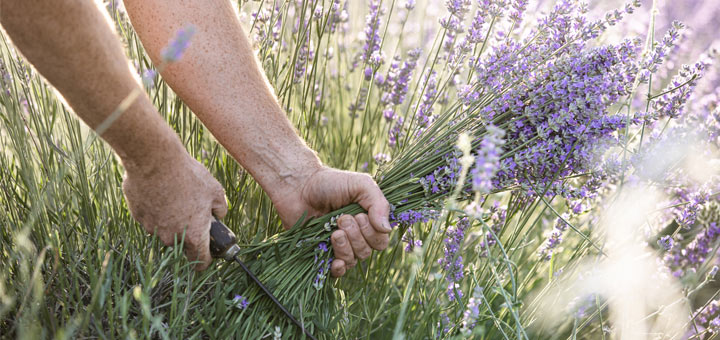What’s not to love about lavender? Bees love it and it brings a burst of color to any garden in which it grows. The vibrant purple flowers offer a beautiful, relaxing aroma and a floral flavor that you can incorporate into beverages and more. It’s rare that people actually harvest their lavender and put the flowers to good use, though. Fortunately, this is a very easy process and we’ll detail simple ways to use what you harvest in this article.
Why Should You Harvest?
Like most other plants, removing the flowering stems from the bush promotes new growth in the plants’ roots. This helps the plant thrive and it keeps it looking tidy. Harvesting the flowering stems not only extends the lifespan of the plant, but also gives the lavender bush more fragrant and fresh lavender flowers to work with in the future. Additionally, learning to use different plants that grow in your garden can help you reduce your reliance on damaging systems. You reduce your consumption of store bought items and you can live in a more eco-friendly and sustainable way.
Health Benefits Of Lavender
There are many types of lavender, but the varieties with long stalks and big flower heads are very appealing. All lavender is wonderfully fragrant and can be incorporated into medicinal, cosmetic, and culinary applications. It’s an ancient herb that has been used for over 2,500 years, according to several sources.
One of the primary benefits of lavender is that it helps promote relaxation, encouraging healthier sleep. Several studies indicated that lavender essential oil was a highly effective remedy for improving sleep quality in people who had difficulty sleeping. A variety of sources also found lavender to be helpful in calming nerves and anxious feelings. The flowers also exhibit antiseptic and anti-inflammatory properties, which may accelerate the healing of minor burns and bug bites. Those same antiseptic properties, coupled with lavender’s antifungal activity, may inhibit the growth of several types of fungus. Finally, lavender essential oil may encourage healthier hair growth!
How To Harvest
When it comes time to harvest your lavender, cut a large group of flowering stems, cutting along the plant. Make sure to leave a few inches of green growth on the plant for future growth. Going down to the woody portion of the stem can stunt the plant’s growth. When you have a small bundle, wrap a rubber band around the bottom of the bundle. Open a small paperclip and use it as a hook to hang the bundle upside down in a cool, dry place. Let the lavender dry out for about a week and then you can use it.
Lavender-Infused Oil
Making your own lavender essential oil is very difficult, but infusing lavender into a carrier oil is very doable. There are a couple ways to infuse lavender, or any herb, into an oil. You can fill a glass jar with the lavender flowers and then pour carrier oil like sweet almond oil or jojoba oil to cover the flowers. Screw on the lid and leave it in the windowsill for about three weeks. You can then strain the oil. A quicker way is to add lavender flowers to a heat-safe glass jar, pour a carrier oil into the jar, and place that jar in a saucepan with an inch or two of water over low heat. Let that infuse for about an hour or two and then let the oil cool before straining.
Lavender Floral Displays
If you grow a lot of lavender in your garden, it’s quite nice to invite its soothing scent into your home. Put fresh lavender cuttings in a simple vase arrangement, or include dried lavender flowers in a floral wreath. Take a wooden wreath base and clad it with lavender and rosemary for an aromatic summertime display. Wreaths aren’t just for the holidays!
Lavender Wands
For these wands, which can sell for big bucks in specialty stores, you’ll want to use freshly picked lavender. Just make sure that the flowers aren’t wet from rain or dew. You’ll need the stalks to be bendable as well. Tie a ribbon around the stalks and under the flower bundle to secure the flowers. Fold the stalks down evenly over the flower head bundle. Weave the ribbon over and under, around and around, the stalk until you completely enclose the flower head. Tie the ribbon at the bottom and you’re ready! Roll the finished wand between your palms to release lavender’s fragrance.
Lavender And Rosemary Hair Rinse
A simple way to encourage healthier hair is by using a nourishing rinse. One thing you can easily do with lavender and rosemary is make a hair rinse. All you have to do is add a few sprigs of lavender and rosemary to a jar of filtered water. Allow it to steep overnight, strain it in the morning, and then add a little apple cider vinegar to it. The next step is to run that rinse through your hair while in the shower. You can experiment and find the right proportion of ingredients for your hair and preferences.

Vincent Stevens is the senior content writer at Dherbs. As a fitness and health and wellness enthusiast, he enjoys covering a variety of topics, including the latest health, fitness, beauty, and lifestyle trends. His goal is to inform people of different ways they can improve their overall health, which aligns with Dherbs’ core values. He received his bachelor’s degree in creative writing from the University of Redlands, graduating summa cum laude. He lives in Los Angeles, CA.






















